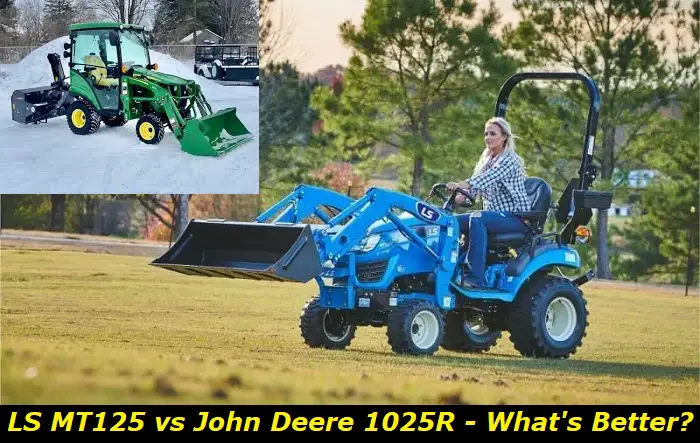LS MT125 VS John Deere 1025R: Difference and Issues
LS MT125 and John Deere 1025R are sub-compact tractors that compete in the same space. The LS MT125 is by LS Tractor, and the 1025R is by John Deere. Both tractors have some similarities. For example, they both utilize the same Yanmar engine and are not far apart in weight and dimensions. As similarly sized tractors, the applications and tasks they are suited for are in the same category.
There are many similarities between the MT125 and 1025R. However, we cannot focus on just similarities. Despite the similarities, we will try to identify some of the differences between the MT125 and 1025R to help potential buyers make an informed choice between these two competing products. Also discussed are Common issues that may be associated with these tractors.

Differences Between the LS MT125 and John Deere 1025R
Technical specifications of the LS MT125 and John Deere 1025R will play a crucial role in this comparison. This section pays attention to various aspects of the MT125 and 1025R tractors. Some comparison areas highlighted are their engines, drivetrains, dimensions, and hydraulics. We will also look at the dealer network and warranty of these machines in the USA.
Engine
For the most part, you are getting very similar offerings from John Deere and LS tractors in terms of the engines of these two tractors. Both the MT125 and 1025R use a Yanmar 3TNV80F engine. The Yanmar 3TNV80F is a 3-cylinder diesel engine. It is also water-cooled. Further, the Yanmar meets a very high standard for emissions. This engine adheres to the US Environmental Protection Agency's Tier 4 Emission standard.
For its aspiration, the 3TNV80F is naturally aspirated, meaning there is no forced induction. The displacement for the engine is 1.267 liters. Bore and stroke are set at 80 and 84 millimeters, respectively.
While the engines in both the MT125 and 1025R are the same, there are some differences in how John Deere and LS Tractor have configured them. The 1025R and MT125 have similar power outputs. However, the gross horsepower rating of the 1025R (23.9 hp) is slightly lower than that of the MT125 (24.7 hp). The slightly higher gross power rating of the MT125 may be helpful for tasks needing extra muscle.
Inversely, the higher rated engine speed of the John Deere 1025R (3200 rpm) may offer some advantages over that of the LS MT125 (3000 rpm). The higher-rated engine of the 1025R may offer some performance advantage, especially when carrying heavy loads.
Drive Train
The LS MT125 and John Deere 1025R both have hydrostatic drive transmissions. The numbers of speeds are also the same, forward and reverse. In terms of drive trains, you are getting on paper very close drive train systems.
PTO
For the Power Take Off (PTO), there are some similarities but also a notable difference between the John Deere 1025R and LS MT125. They both have independent PTOs that can power various implements. The rear PTO on both tractors has a standard PTO with 540 rpm. The mid-PTO is, however, different. The MT125 can offer a higher rpm of 2500 compared to the 1025Rs 2100 rpm.
Hydraulics
The narrative is similar here. The LS MT125 and John Deere 1025R are not far from each other when you observe their hydraulics. The implement pump rate on the John Deere 1025R is lower (3.5 gpm) than the LS MT125 (4.6 gpm). The MT125's higher implement pump rate can help with implements that require more flow.
Contrarily, the 1025R has a higher steering pump rate of 3.5 gpm compared to the LS MT125's 2.1 gpm. You can get more responsive steering due to the 1025R's higher steering pump rate. For total flow, you will get 6.7 gpm on the MT125 and a slightly lower 6.3 gpm on the 1025R.
The 3-point hitch of the MT125 and 1025R offers another useful point of comparison. They both have a category 1 3-point hitch with position control. The rear lift on the John Deere 1025R can do 758 pounds at 24 inches, while the LS MT125 can get to a slightly lower 728 pounds.
Dimensions and tires
The wheelbase of the LS MT125 and John Deere 1025R are quite close. The MT125 has a smaller 56-inch wheelbase compared to the 1025R's 57.1 inches. Theoretically, a wider wheelbase will provide more stability and room to maneuver in certain circumstances. However, the difference here is so negligible we do not think it matters too much.
Without a cab, the LS MT125 weighs 1444 pounds, which is smaller than the John Deere 1025Rs 1556 lbs. The heavier tractor could be more stable.
Tire options offer no separation. Both LS MT125 and John Deere 1025R offer R3 turf and R4 industrial tire options at the front and rear with the same dimensions.
Attachments
To vary a tractor's utility, you need attachments. John Deere 1025R and LS MT125 support an extensive number of attachments. Below, we list the attachments officially supported by the respective manufacturers of the MT125 and 1025R.
LS MT125 Supported Attachments
- Front end loader - LL1102, LL1100
- Backhoe - LB1107
- Mid-mount mower - LM1160
- Snow blower - LW3150
- Grass catcher - MGC1715, MGC1722 Pro
- Box blade - MBB3048
- Rake grapple - MCG1148A
- Tiller - MRT1548A
John Deere 1025R Supported Attachments
- Front end loader - D120, H120
- Rotary mid-mount mower - 54D-in
- Backhoe - 260D
- Rotary cutter - RC2048
- Box blade - 48"
- Land plane - 48"
- Snow blower - 47", 48"
- Blade - 60" rear
- Rotary broom - 52", 60"
- Rotary tiller
- Rake
- Power rake
- Manure spreader
- Sprayer
The 1025R has a higher number of supported attachments from its manufacturer, which should provide more versatility for it than the MT125. However, the MT125 is no slouch and has most of the popular attachments.
Pricing
Exact pricing for either of these tractors is not so straightforward. Prices will vary with location and dealers. However, a cursory look at the prices of both tractors on the internet shows that the starting price of the LS MT125 is much lower than the John Deere 1025R's.
The MT125 can be found for between $14,999 and $15,999 for the base model. On the other hand, the 1025R starts from $ 18,396 on John Deere's official website. If you are price-sensitive, choosing the LS MT125 will save you a few thousand dollars more than a similar-spec John Deere 1025R.
Dealer Network
Globally, John Deere is a titan in machinery manufacturing. Their reach spreads across the world, and they are the most popular machinery brand in the USA. This popularity is also visible in the number of dealers and experts available for their machines. LS tractor, which is originally a Korean brand, has gained prominence in recent decades yet does not have the same wide reach that John Deere has.
If the availability of dealers, parts, and experts is a key factor, the John Deere 1025R is your best option. However, check for the availability of dealers in your immediate locale. You may find that you have enough support to choose the LS MT125.
Warranty
The John Deere 1025R and LS MT125 come with extensive warranties. Any John Deere tractor you get from an authorized dealer will come with a 2-year full warranty and a 6-year or 2000-hour powertrain warranty. LS tractors like the MT125 come with a 6-year warranty as well. The MT125 warranty includes a 2-year bumper-to-bumper protection. These tractors are also similar here.
John Deere 1025R and LS MT125 Issues
Another important area for comparison would be common issues associated with either of these machines. Nobody wants to purchase a problematic tractor. While it is our intention to help users make informed purchases, we cannot create issues out of thin air. The fact is that the LS MT125 and John Deere 1025R are two solid tractors that have received a lot of commendation.
While you will find issues here and there regarding both tractors, none of them are a staple or recurrent enough to be permanently associated with either tractor. Nevertheless, there are some general tractor problems that can affect either the LS MT125 or John Deere 1025R, such as:
- Engine starting problems
- Hydraulic problems
- Transmission problems
- Fan belt issues
- Starting issues
- Debris accumulation
Summary
Both tractors are comparatively well spec'd, and there is not so much in between them. Their drivetrains are similar, and areas with differences show only slight gains or weaknesses. You get better gross horsepower from the LS MT125 and better rated engine speed from the John Deere 1025R. Additionally, there are slight differences in the PTOs, hydraulics, and dimensions. Both John Deere and LS also offer similar warranties for these machines.
Dealer availability or pricing may break the tie. The 1025R will have more dealers due to John Deere's wider reach. However, you could save thousands by choosing the MT125. In terms of issues, there are no major issues linked with either the MT125 or 1025R. Ultimately, your choice will depend on your needs, budget, and availability. If you can, get a hands-on feel of both tractors before you choose. Getting a hands-on feel may help you with your choice.

Add comment